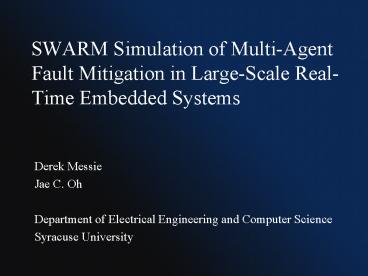SWARM Simulation of MultiAgent Fault Mitigation in LargeScale RealTime Embedded Systems - PowerPoint PPT Presentation
1 / 19
Title:
SWARM Simulation of MultiAgent Fault Mitigation in LargeScale RealTime Embedded Systems
Description:
SWARM Simulation of Multi-Agent Fault Mitigation in Large-Scale Real-Time ... studying matter-antimatter asymmetries in the decays of particles containing the ... – PowerPoint PPT presentation
Number of Views:53
Avg rating:3.0/5.0
Title: SWARM Simulation of MultiAgent Fault Mitigation in LargeScale RealTime Embedded Systems
1
SWARM Simulation of Multi-Agent Fault Mitigation
in Large-Scale Real-Time Embedded Systems
- Derek Messie
- Jae C. Oh
- Department of Electrical Engineering and Computer
Science - Syracuse University
2
BTeV
- A particle accelerator-based High Energy Physics
(HEP) experiment at Fermi National Laboratory
studying matter-antimatter asymmetries in the
decays of particles containing the bottom quark.
3
Real-Time Embedded Systems Collaboration (RTES)
- Design real-time embedded intelligent software to
ensure data integrity and fault-tolerance within
the BTeV data acquisition system. - Fermi National Accelerator Laboratory (BTeV)
- Syracuse University (Very Lightweight Agents /
Load Balancing) - Vanderbilt University (Graphical Modeling
Environment) - University of Illinois (Adaptive, Reconfigurable,
and Mobile Objects for Reliability) - Sponsored by NSF
4
BTeV Triggering and Data Acquisition System
5
Very Lightweight Agents (VLAs)
- Monitor hardware / software integrity
- Intelligent / Adaptive
- Reactive / Proactive
- Small footprint
- Fast
- Hierarchical
6
VLA Hierarchy
Regional VLA
Farmlet
Buffer Manager
Farmlet Manager
Farmlet VLA
Worker
Worker VLA
PA
Local Manager
7
SC2003 Prototype
- 7-slot VME crate with 4 fully populated
motherboards. - 16 DSPs
- TI C6711 with 64 M of RAM at 166 MHz
- Graphical Modeling Environment (GME) to model the
RTES/BTeV data acquisition system.
8
BTeV Error Scenarios Modeled
9
Challenges
- Scalability ? (16 lt gt 2500)
- Centralized expert system approach not
effective given - of real-time components / states
- Failover redundancy
10
VLA Design Motivation
- Subsumption Architecture
- (Brooks 1986)
- Mobile robot design
- Multiple layers of distributed sensors
- Decentralized, bottom-up approach
- Higher levels subsume lower levels
- Increasing levels of competence
11
Mobile robot layers of competence
- 0. Avoid contact with objects (moving or
stationary). - Wander aimlessly around without hitting things.
- Explore the world by seeing places in the
distance which look reachable and heading for
them. - Build a map of the environment and plan routes
from one place to another. - Notice changes in the static environment.
- Reason about the world in terms of identifiable
objects and perform tasks related to certain
objects. - Formulate and execute plans which involve
changing changing the state of the world in some
desirable way. - Reason about the behavior of objects in the world
and modify plans accordingly.
12
VLA layers of competence
- 0. Act on local reactive rules.
- Monitor local components and activate local
proactive rules. - Analyze and act on statistics gathered from rule
firing. - Map the local state of the environment.
- Reason about the system in terms of accumulated
statistics and the state of connected components. - Formulate and execute actions which involve
changing the state of the system in some
desirable way. - Reason about the behavior of components in the
system and modify plans accordingly.
13
SWARM (www.swarm.org)
- Multi-agent simulation of complex systems.
- GNU General Public License
- Java or Objective-C development kit
14
BTeV Components Modeled
Regional VLA
Farmlet
Buffer Manager
Farmlet Manager
Farmlet VLA
Worker
Worker VLA
PA
Local Manager
15
SWARM Simulation
- Buffer Manager
- queue volume
- Physics Application (PA)
- Injects error scenarios at individual DSPs.
(random and manual) - VLA (Worker, Farmlet, Regional)
- Reactive and proactive rule set
- Local Manager
- Additional DSP fault handling
16
SWARM Simulation (cont.)
- Component message logs
- Global behavior tracking
- Error rates
- Recovery rates
- Buffer queue levels
17
(No Transcript)
18
Lessons Learned / Future Work
- Subsumption Architecture vs. Traditional
Hierarchical Systems - More focus on adaptive qualities of VLA
- Self-organizing VLAs
- Cooperation within scheduling algorithm
19
Questions ?

